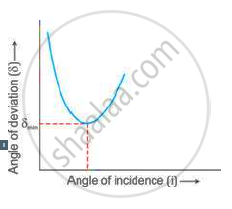Advertisements
Advertisements
Question
Solution
APPEARS IN
RELATED QUESTIONS
When a ray of light travels from air to glass slab and strikes the surface of separation at 90°, then it …………….
(a) bends towards normal
(b) bends away from normal
(c) passes unbent
(d) passes in zigzag way
Write a short note on dispersion of light.
Fig shows a lens as a combination of a glass block and two prisms.
(i) Name the lens formed by the combination.
(ii) What is the line XX' called?
(iii) Complete the path of the incident ray PQ after passing through the lens.
(iv) The final emergent ray either meets XX' at a point or appears to come from a point on XX'. Label it as F, What is this point called?
Using the curve, how do you infer that for given prism, the angle of minimum deviation δmin is unique for the given light?

Why is the colour red used as a sign of danger?
What is the refractive index of vacuum
Comment on the statement ‘The refractive index of glass is 3/2.’
Draw a diagram to show the refraction of a monochromatic light ray through an equilateral prism. On the diagram, label the incident, refracted, and emergent rays. It also indicates the angle of deviation by the letter δ.
The speed of light in air is 3 × 108 ms-1. Calculate the speed of light in water. The refractive index of water is 4/3.
